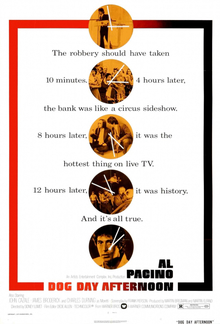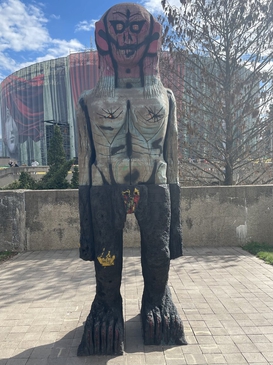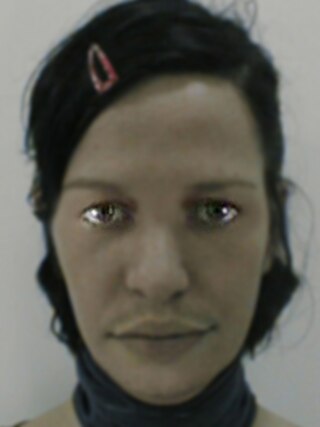Related Research Articles

Impressionism was a 19th-century art movement characterized by relatively small, thin, yet visible brush strokes, open composition, emphasis on accurate depiction of light in its changing qualities, ordinary subject matter, unusual visual angles, and inclusion of movement as a crucial element of human perception and experience. Impressionism originated with a group of Paris-based artists whose independent exhibitions brought them to prominence during the 1870s and 1880s.

Dog Day Afternoon is a 1975 American biographical crime drama film directed by Sidney Lumet and produced by Martin Bregman and Martin Elfand. The film stars Al Pacino, John Cazale, James Broderick, and Charles Durning. The screenplay is written by Frank Pierson and is based on the Life magazine article "The Boys in the Bank" by P. F. Kluge and Thomas Moore. The feature chronicled the 1972 robbery and hostage situation led by John Wojtowicz and Salvatore Naturile at a Chase Manhattan branch in Brooklyn.

Jean-Antoine Watteau was a French painter and draughtsman whose brief career spurred the revival of interest in colour and movement, as seen in the tradition of Correggio and Rubens. He revitalized the waning Baroque style, shifting it to the less severe, more naturalistic, less formally classical, Rococo. Watteau is credited with inventing the genre of fêtes galantes, scenes of bucolic and idyllic charm, suffused with a theatrical air. Some of his best known subjects were drawn from the world of Italian comedy and ballet.

Wifredo Óscar de la Concepción Lam y Castilla, better known as Wifredo Lam, was a Cuban artist who sought to portray and revive the enduring Afro-Cuban spirit and culture. Inspired by and in contact with some of the most renowned artists of the 20th century, including Pablo Picasso, Henri Matisse, Frida Kahlo and Diego Rivera, Lam melded his influences and created a unique style, which was ultimately characterized by the prominence of hybrid figures. This distinctive visual style of his also influences many artists. Though he was predominantly a painter, he also worked with sculpture, ceramics and printmaking in his later life.

Sophie Calle is a French writer, photographer, installation artist, and conceptual artist. Calle's work is distinguished by its use of arbitrary sets of constraints, and evokes the French literary movement known as Oulipo. Her work frequently depicts human vulnerability, and examines identity and intimacy. She is recognized for her detective-like tendency to follow strangers and investigate their private lives. Her photographic work often includes panels of text of her own writing.

John Stanley Joseph Wojtowicz was an American bank robber whose story inspired the film Dog Day Afternoon.

Pierre Jean Louis Germain Soulages was a French painter, printmaker, and sculptor. In 2014, President François Hollande of France described him as "the world's greatest living artist." His works are held by leading museums of the world, and there is a museum dedicated to his art in his hometown of Rodez.

Pierre Bismuth is a French artist and filmmaker based in Brussels. His practice can be placed in the tradition of conceptual art and appropriation art. His work uses a variety of media and materials, including painting, sculpture, collage, video, architecture, performance, music, and film. He is best known for being among the authors of the story for Eternal Sunshine of the Spotless Mind (2004), for which he won the Academy Award for Best Original Screenplay alongside Michel Gondry and Charlie Kaufman. Bismuth made his directorial debut with the 2016 feature film Where is Rocky II?.

The Walter Phillips Gallery (WPG) is a contemporary art gallery in Banff, Alberta. It was established in 1976 as a part of The Banff Centre in Banff National Park.
Matthew Day Jackson is an American artist whose multifaceted practice encompasses sculpture, painting, collage, photography, drawing, video, performance and installation. Since graduating with an MFA from Rutgers University in 2001, following his BFA from the University of Washington in Seattle, he has had numerous solo exhibitions. His work has been shown at MAMbo Museo d'Arte Moderna in Bologna, Italy; Boulder Museum of Contemporary Art in Boulder, Colorado; the Museum of Fine Arts in Boston, MA; the Portland Museum of Art Biennial in Portland, Maine; and the Whitney Biennial Day for Night in New York.
Philippe Parreno is a French contemporary artist, living and working in Paris. His works include films, installations, performances, drawings, and text.

Huma Bhabha is a Pakistani-American sculptor based in Poughkeepsie, New York. Known for her uniquely grotesque, figurative forms that often appear dissected or dismembered, Bhabha often uses found materials in her sculptures, including styrofoam, cork, rubber, paper, wire, and clay. She occasionally incorporates objects given to her by other people into her artwork. Many of these sculptures are also cast in bronze. She is equally prolific in her works on paper, creating vivid pastel drawings, eerie photographic collages, and haunting print editions.
Claude Viallat is a French contemporary painter.

François Roche is a French architect. Roche is the co-founder and director of R&Sie(n) Architects and the research architectural firm, New Territories/M4.
Camille Henrot is a French artist who lives and works in Paris and New York.
Philippe Vergne is a French curator who has been serving as director of the Serralves Contemporary Art Museum since 2019.
Larissa Sansour is a Palestinian artist who currently resides in London, England. Her practice includes photography, film, sculpture, and installation art. Some of her works include Tank (2003), Bethlehem Bandolero (2005), Happy Days (2006), Cairo Taxilogue (2008), The Novel of Novel and Novel (2009), Falafel Road (2010), Palestinauts (2010), Nation State (2012), In the Future, They Ate From the Finest Porcelain (2016), and Archaeology in Absentia (2016).

Mezzetino is an oil-on-canvas painting in the Metropolitan Museum of Art, New York, by the French Rococo painter Jean-Antoine Watteau. Dated within 1717–1720, Mezzetino forms a full-length single-figure composition, depicting the eponymous character in commedia dell'arte. In the 18th century, Mezzetino was owned by Jean de Jullienne, the friend and patron of Watteau who supervised the four-volume edition of prints after the artist's works, for which the picture was engraved by Benoit Audran the Elder; after Jullienne's death in 1766, it was acquired for the Hermitage in Saint Petersburg, then recently established by Empress Catherine II of Russia. During the Soviet sales in the 1920s and 1930s, Mezzetino was sold to British-American businessman Calouste Gulbenkian; it was later sold to the Wildenstein art firm in Paris and New York, from which it was bought in 1934 by the Metropolitan Museum of Art, where it remains; the institution also owns a preparatory study—a drawing of the man's head.
Lucie Dolène was a French actress and singer. She notably dubbed the voices of Snow White and Mrs. Potts. Her autobiography, cowritten by Grégoire Philibert, was published in 2021.

Charwei Tsai is a Taiwanese multidisciplinary artist who lives and works in Taipei, Taiwan.
References
- Stech, Fabian (2006). J'ai parlé avec, Lavier, Annette Messager, Sylvie Fleury, Hirschhorn, Pierre Huyghe, Delvoye, Le Consortium, D.G.-F., Hou Hanru, Sophie Calle, Ming, Sans et Bourriaud. Dijon: Presses du réel. ISBN 2-84066-166-7.
- Barikin, Amelia (2012). Parallel Presents: The Art of Pierre Huyghe. Cambridge, MA: MIT Press. ISBN 978-0-262-01780-0.
- Huyghe, Pierre; Garcia, Tristan; Lavigne, Emma; Normand, Vincent (2014). Pierre Huyghe, Germany, Hirmer Verlag